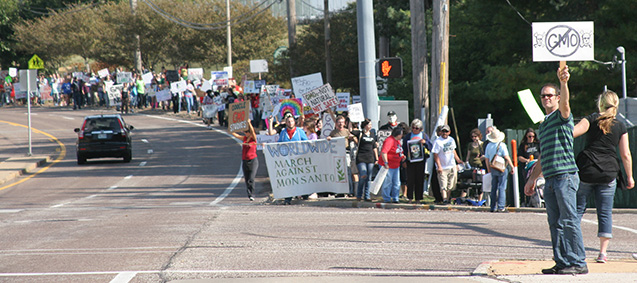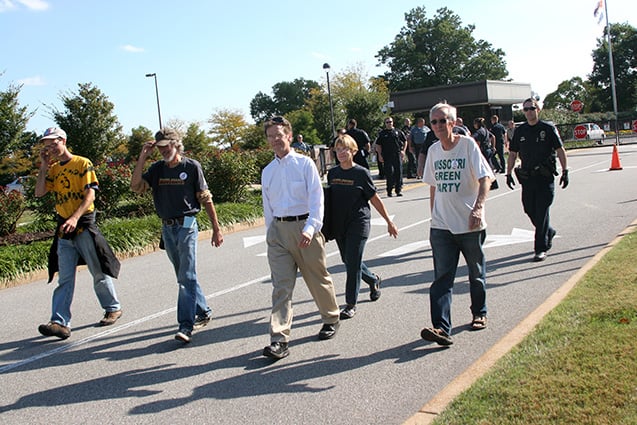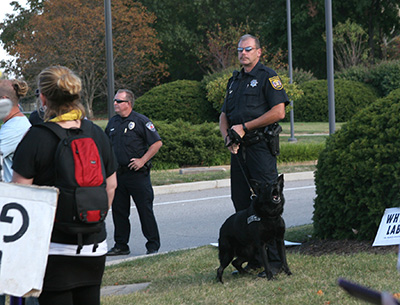Honest, paywall-free news is rare. Please support our boldly independent journalism with a donation of any size.
At the October 12, 2013, March Against Monsanto at Monsanto Worldwide Headquarters in St. Louis, scores of police from half a dozen municipalities were there, some with dogs. Growing demands for reparations to the victims of Monsanto’s crimes will be heard at a November 8-9 “People’s Hearing on Monsanto: Crimes and Reparations.”
The days of Monsanto greeting protesters at its World Headquarters (MWH) with balloons and pitchers of water are over. When 500 to 700 showed up for the October 12, 2013, March Against Monsanto (MAM), scores of police from half a dozen municipalities were there, several with dogs.
Also gone were police attempts to micromanage demonstrators. During a previous demonstration, police told picketers to stand on the pavement and not on Monsanto’s grass. At the next event, cops said that the pavement was too close to traffic and ordered people to stand on the grass. October 12 was noticeable by the absence of police commands concerning where to stand. At first, they seemed to have given up on controlling the increasingly large crowd.
Since the 1990s, marchers at MWH mostly have been environmentalists and Vietnam War veterans who had been radicalized in the 1960s. At MAM events in May and October 2013, there were hundreds of activists who had not even been born in the 1960s.
A mixture of joyful exuberance and angry rejection of the company’s efforts to control and contaminate food permeated the crowd, which spilled onto both sides of the 50 mph traffic racing by Monsanto’s Olive Boulevard entrance. As cars slowed to appreciate the multitude of signs, young activists poured into the street, handing out literature. Cars slowed to a stop, bringing more demonstrators into the street. Police and dogs advanced toward the crowd. Demonstrators backed off and cleared the road. Cops moved back. No arrests.
This cycle repeated itself four or five times during the two-hour happening. At one point, several of us wrote a list of reparation requests for the Monsanto CEO. We had not expected to get past the police line blocking the entrance, but the police line unexpectedly evaporated as a road block occurred at the same time we began moving. The person in the guard shack shut the window tight as we approached. A squad of eight to ten private Monsanto security guards rapidly walked up to us. We presented the list to the head goon and retreated. No arrests.
 Small portion of demonstrators at MWH. (Photo: Jeff Schaefer.)
Small portion of demonstrators at MWH. (Photo: Jeff Schaefer.)
From PCBs to GMOs
In some ways, the protest at the MWH was similar to others involving 2 million people around the world. Food was the big issue of the day. People were outraged at Monsanto’s reckless pursuit of putting genetically modified organisms (GMOs) into food with unknown effects for consumers, especially children. They unleashed their anger at the company’s attempts to manipulate the world food supply. At its attacks on farmers. At the havoc that GMOs wreak on wildlife. And at the company’s complicity with land grabs for planting GMO monocultures in Latin America, Asia and Africa.
During the press conference before the rally, local farmer Mark Brown alerted the crowd to the danger posed by patenting GMOs and Monsanto’s aggressive lawsuits against farmers for saving seeds. He encouraged everyone to support seed-saving and to grow their own food.
But the St. Louis event differed from other actions around the world. Because Monsanto originated in St. Louis, many nearby areas continue to be contaminated from its chemical past. These include East St. Louis, Illinois; Carter Carburetor in north St. Louis; and the Times Beach incinerator site, which burned dioxin (and probably Monsanto’s PCBs) in the 1990s.
 Monsanto security ensures activists leave guard shack. Left to right: Mark Bohnert, digger, David Arnold, Barbara Chicherio, Don Fitz. (Photo: Jeff Schaefer)
Monsanto security ensures activists leave guard shack. Left to right: Mark Bohnert, digger, David Arnold, Barbara Chicherio, Don Fitz. (Photo: Jeff Schaefer)
At the press conference, Zaki Baruti, of the Universal African Peoples Organization and Green Party of Missouri, told of growing up in East St. Louis in the shadow of Monsanto’s Krummrich Plant which released waste directly into the public sewer system, polluting water and soil with PCBs and other toxins. PCBs were banned in 1970, but Monsanto was aware of their health risks as early as 1940.
Romona Taylor-Williams recounted the fight waged by M-SLICE (Metro St. Louis for Inclusion and Equality) to get a cleanup for the Carter Carburetor site in predominantly black north St. Louis. Monsanto sold PCBs to Carter Carburetor despite its knowledge that they cause cancer. Yet, the current cleanup plan for the Carter Carburetor site does not hold Monsanto responsible.
The Green Party of St. Louis has been opposing Monsanto products for more than 20 years. It includes many black members who are committed to reparations for slave descendants. The idea of reparations has now become a central concept among many organizing in St. Louis against Monsanto.
What are reparations?
Reparations for slave descendants would start with an acknowledgement of the wrong done and an apology for that wrong as a preparation for social and financial compensation. Similarly, reparations from Monsanto would begin with the company’s acknowledging that it has a history of contaminating communities of color and low-income communities across the United States. It would acknowledge that it helped poison US veterans and millions of Vietnamese with Agent Orange before it began its current crusade to monopolize the world’s food with a War on Farmers. It would apologize for these crimes. And it would begin a series of discussions with its victims concerning how it should compensate them.
During the October 12 press conference, Zaki Baruti said:
– Monsanto needs to apologize for practicing extreme environmental racism in East St. Louis; in north St. Louis at the Carter Carburetor site; Anniston, Alabama; and other cities and towns.
– Monsanto must take responsibility for poisoning the citizens of East St. Louis. Monsanto needs to clean up the city, ridding it of PCBs and other dangerous chemicals.
– Monsanto needs to build a state-of-the-art hospital that would serve all of the residents at no cost and to treat those sickened by exposure to Monsanto’s chemicals.
– Monsanto needs to establish a trust fund to annually grant adequate amounts of money to the East St. Louis school system.
 Monsanto’s alternative to happy face greeting of protestors. (Photo: Jeff Schaefer)St. Louis is not waiting with baited breath for Monsanto to do the right thing. Exactly the opposite occurred in its official response to actions of October 12: “While we respect that people can have different points of view, we hope that St. Louisans know Monsanto people for their role in the community and know the Monsanto company for its commitment to St. Louis.” This weak response highlights that Monsanto has a crumbling global image because its lies of ending world poverty, selling safe products and using environmentally sound practices are no longer believed.
Monsanto’s alternative to happy face greeting of protestors. (Photo: Jeff Schaefer)St. Louis is not waiting with baited breath for Monsanto to do the right thing. Exactly the opposite occurred in its official response to actions of October 12: “While we respect that people can have different points of view, we hope that St. Louisans know Monsanto people for their role in the community and know the Monsanto company for its commitment to St. Louis.” This weak response highlights that Monsanto has a crumbling global image because its lies of ending world poverty, selling safe products and using environmentally sound practices are no longer believed.
The struggle against Monsanto is intensifying as a new awareness emerges that it must make up for the harm it has done. This will be the focus of the November 8-9, 2013, “People’s Hearing on Monsanto: Crimes and Reparations.” If you would like to join us in St. Louis for the event, please visit gmofreemidwest.org or call 314-727-8554. The next international March Against Monsanto will be May 24, 2014. Meet us in St. Louis at the Olive Street entrance to Monsanto World Headquarters.
Cries for reparations will not bring joy to Monsanto. As opposition expands beyond objecting to its crimes and includes demands for compensation to all of its victims, demonstrators may see fewer Monsanto balloons with happy faces and more police dogs.
Press freedom is under attack
As Trump cracks down on political speech, independent media is increasingly necessary.
Truthout produces reporting you won’t see in the mainstream: journalism from the frontlines of global conflict, interviews with grassroots movement leaders, high-quality legal analysis and more.
Our work is possible thanks to reader support. Help Truthout catalyze change and social justice — make a tax-deductible monthly or one-time donation today.
